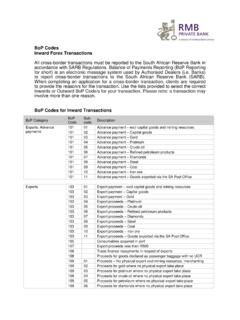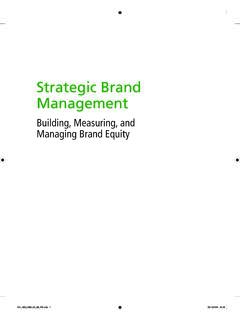Transcription of PRIVATE MARKETS INSIGHTS: CO-INVESTMENT SERIES …
1 CO- investing 101: benefits AND risks / page 1 CO- investing 101: benefits AND RISKSPRIVATE MARKETS insights : CO-INVESTMENT SERIEST here is significant interest in co- investing , but not everyone has the skills and resources required to successfully execute a CO-INVESTMENT program. Investors in recent years have been drawn to co- investing for its potential to generate outperformance at reduced costs, as well as the opportunity it brings to be more actively involved in managing their portfolios. As more investors consider establishing programs, or adding to their existing allocations, it is critical that they fully understand both the dynamics of co- investing and the range of competencies required to be successful.
2 Throughout this SERIES , HarbourVest s global CO-INVESTMENT team which has invested over $6 billion of CO-INVESTMENT capital since 1989 will share its collective insights and experiences to help make you a more successful co-investor. Part I of the SERIES focuses on the basics, including a look at the benefits and risks inherent in co- investing . PRIVATE equity has experienced spectacular growth over the past three decades as institutional investors have been drawn to the asset class by its consistent ability to outperform public market the industry has grown, it has expanded rapidly in terms of strategic offerings, regional and industry coverage, and stages of investment . Growing investor demand for PRIVATE investment opportunities has also compelled the industry to develop new ways for investors to access these transactions, and to become more engaged in the actual deal process.
3 Historically, the most common way to participate in PRIVATE investing has been through commingled funds, or blind pools of capital structured as limited partnerships. The investors in these funds known as limited partners (LPs) delegate investment decision-making authority to the general partner (GP), or lead manager. In return for making investments into portfolio companies and managing these investments throughout their life, the GP is paid a management fee and receives carried interest, or a percentage of the profits that are generated by its investments. The funds themselves typically have life spans of 10 or more s global investment team has invested more than $6 billion of CO-INVESTMENT capital since 101: benefits AND risks / page 2 While commingled funds remain the dominant vehicle for accessing PRIVATE MARKETS , more GPs are offering CO-INVESTMENT opportunities to their LPs.
4 In a single company CO-INVESTMENT , an LP invests in a PRIVATE or public operating company alongside, and typically at the invitation of, a GP. The lead manager is generally responsible for managing the portfolio company and may offer CO-INVESTMENT opportunities for a number of reasons including to bridge a funding gap or to bring additional skills and resources to an the potential for higher returns and more direct involvement has generated significant interest in co- investing , investors need to understand the risks that come with co- investing as CO-INVEST?Many investors are familiar with the headline benefits that co- investing can offer. Strong performance track record. Lower fees. The chance to be more involved in the day-to-day management of their portfolios.
5 Let s take a deeper dive into the different ways co- investing can enhance your PRIVATE MARKETS CONTROL OVER CAPITAL DEPLOYMENT PACING. Commingled funds will always be an attractive method by which investors can gain exposure to PRIVATE MARKETS . However, unlike committing to a commingled fund where the lead manager has full discretion on when, where, and with whom to make investments co- investing provides the flexibility to further customize your investment strategy. For instance, an investor can use co-investments to efficiently deploy capital to deals in a specific region, industry, or manager that they wish to target, allowing it to better take advantage of short-term trends and tailwinds, as well as match its investment pacing to its cash flow POTENTIAL.
6 Gaining access to top-tier GPs and a large number of opportunities can be a major performance driver, and when you select well the potential for outperformance grows. Co- investing also provides a less expensive fee structure compared to traditional PRIVATE equity funds. Recent research shows that while average gross returns for co-investments are similar to gross returns for GP-led funds, CO-INVESTMENT returns are meaningfully higher on a net The following chart compares the performance of a CO-INVESTMENT fund to a traditional PE fund. Co-Investor/Limited Partner(insurance company, pension fund, endowment, foundation, fund-of-funds, etc.)Lead Manager/General Partner( PRIVATE Equity Firm) PRIVATE Equity Fund(Limited Partnership)Portfolio Company( investment in an operating company, controlled by the lead manager)Co-Investor may also be an investor in the fundEquity CO-INVESTMENT (Minority Ownership)Fund investment (Majority Ownership)1 Reiner Braun, Tim Jenkinson, and Christoph Schemmerl, Adverse Selection and the Performance of PRIVATE Equity Co-Investments, November StructureCO- investing 101: benefits AND risks / page 3 STRONGER RELATIONSHIPS WITH TOP-TIER GPs.
7 Because co- investing requires a hands-on approach, investors get the chance to work closely with top GPs to foster deeper relationships and gain a better understanding of their investment strategies and processes. For the co-investor, building these relationships is essential for gaining access to future deal flow and for building their own investment skills. ACCESS TO PRE-QUALIFIED DEALS. The opportunities made available to co-investors are typically pre-screened by the lead manager, who performs extensive due diligence and vetting to ensure that the highest quality deals are selected. As a result, the opportunities that a co-investor is offered tend to be high-quality Fund vs. Traditional PE Fund Example: $ billion fund, invests $200 million per year evenly over 5 years, generates a gross portfolio return of * Invested capital includes any investments funded through a financing facility.
8 In the event that cumulative capital committed to investments, including reinvested capital, ever exceeds total committed capital, then the management fee will be based on the lower committed capital number. Shown for illustrative purposes only. Not intended to project performance. Assumes 100% of committed capital invested and gross portfolio return in both scenarios. Management fees are paid through portfolio proceeds beginning in Year 5. Both scenarios have an identical schedule of gross distributions. IRRs are calculated based on annual cash flows, assuming capital called in mid-year and NAV as of year-end. IRRs reflect assumption of NAV increase in Years 2 through 10. Does not reflect organizational costs and other fund level operating expenses.
9 No cash balance is modeled, , all fund excess cash is distributed to LPs. The carried interest accrues to the general partner s account as it is generated and is paid to the general partner in Years 9 and 10. CO-INVESTMENT fund fees and carried interest are based on HarbourVest CO-INVESTMENT IV Fund mitigationin early years-20% -15% -10% -5% 0% 5% 10% 15% 20% Year 1 Year 2 Year 3 Year 4 Year 5 Year 6 Year 7 Year 8 Year 9 Year 10 Net LP IRR CO-INVESTMENT Fund Tr aditional Fund Long-term outperformanceCo- investment Fund Fee: 1% of invested capital*Carry: 10% up to 2x, then 20% with no catch upTraditional Fund Fee: 2% of committed capital Carry: 20%Return $215 million more cash to LPs representing 53% less fees and carry paid than a traditional fund structureCO- investing 101.
10 benefits AND risks / page 4 KNOW THE risks While the benefits of co- investing can be substantial, long-term success requires a thorough understanding of the potential risks . CO-INVESTMENT deals are generally complex, require extensive resources, involve multiple steps from deal sourcing to post- investment monitoring and often need to be completed in a short period of time. Knowing the caution flags to look for, and responding accordingly, is essential. Potential risks may include:RESOURCE-INTENSIVE PROCESS. Executing a CO-INVESTMENT strategy requires significant resources to create a large pipeline of opportunities; evaluate both the lead manager offering the opportunity as well as the company in which they may invest; and to close and monitor the investments as they mature.







